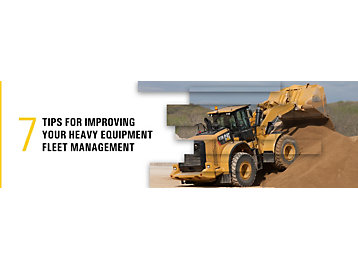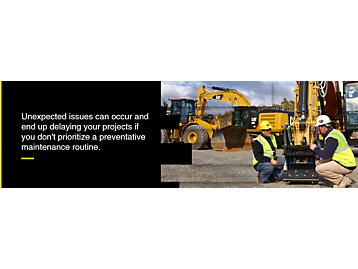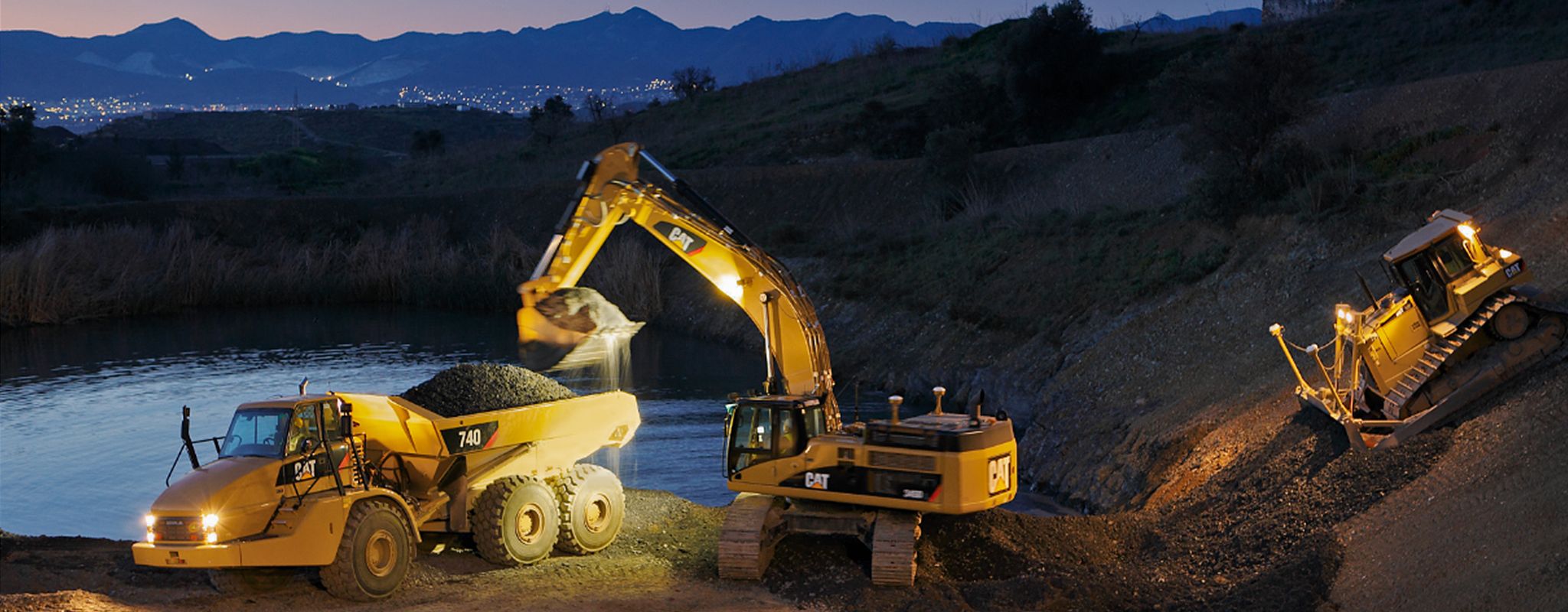

Sign In
Welcome! Sign In to personalize your Cat.com experience
If you already have an existing account with another Cat App, you can use the same account to sign in here
Register Now
One Account. All of Cat.
Your Caterpillar account is the single account you use to log in to select services and applications we offer. Shop for parts and machines online, manage your fleet, go mobile, and more.
Account Information
Site Settings
Security
Author: Small Business Expert | January 23, 2023 | Topic: Used Equipment

Heavy equipment requires regular maintenance, inspections, repairs and even replacements. This equipment is a large investment for your company, so it's important you manage it properly. Maintaining a large fleet of complex equipment can be challenging, especially if you're trying to expand your company.
In this heavy equipment fleet management guide, we'll discuss different tools that can help you maintain your machines and ways to improve heavy equipment fleet efficiency.
What Is Heavy Equipment Fleet Management?
Construction equipment fleet management involves many aspects of managing machinery, including:
- Purchasing
- Renting
- Organization
- Coordination
- Maintenance
- Replacements
- Data reporting
- Record-keeping
This administrative approach ensures your company always has working equipment on hand to avoid project delays and unexpected, costly repairs. Each company, project and operation will have unique challenges, and fleet management allows you to stay on top of your equipment and know exactly what you need to replace or inspect.
Fleet management also requires overseeing and supervising your heavy equipment and ensuring proper care, operator training and upkeep to minimize risks on the job. Though fleet management can look different for every company, the primary goal is to improve the overall performance of your fleet and improve safety and efficiency.
Why Is Heavy Equipment Fleet Management Important?
A fleet of heavy equipment is one of the biggest investments you can make in your construction company. Fleet management is necessary for keeping your equipment in good condition, finding ways to keep costs low and running a successful business. Likewise, fleet management can help you increase efficiency and productivity and make it easier to maintain your machinery.
If you run a large company or have several projects spread across the city or state, it can be difficult to locate your diggers and forklifts when you don't have a procedure to keep an eye on them. Fleet management can be the most important thing for your bottom line. For instance, if one of your forklifts is late getting delivered to a job site, your entire project can fall behind schedule, leading to reduced profitability and a damaged business reputation.
Ways to Improve Your Heavy Equipment Fleet Management
Managing a fleet can be challenging because there are so many critical aspects to track. Follow these heavy equipment fleet management tips to keep your fleet in top working condition and avoid costly mistakes.
1. Know the Limits
Knowing your heavy equipment's work capability is crucial for effective management. Be sure to communicate with operators about proper usage and determine each machine's weight capacity and life cycle. It's also important to assess how components in your equipment can affect their function. Likewise, you'll want to know any weather changes that can influence your machine's performance.
2. Minimize Access
Managing your heavy equipment fleet requires protecting your assets and keeping your equipment secure. By limiting access to your machines, you can help prevent theft and misuse. Keep your equipment stored securely in a warehouse or job site with security measures, such as keypads, barriers or security. The only people who should be near or on your equipment are your workers and trained operators.
3. Conduct Regular Inspections
One of the best tips for heavy equipment fleet management is taking preventative measures, such as detecting damage with regular inspections. Whether you've used your machine for five minutes or five months, it's critical to ensure your components are in good condition to prevent worse — and more expensive — issues from occurring down the line. Be sure to train your operators to look for even the most minor damage to your equipment's wheels, tracks, interior and exterior.
4. Perform Routine Maintenance
Performing routine maintenance is imperative to keeping your fleet in good condition. As with inspections, it's not wise to overlook regular maintenance — even if your equipment looks good on the outside. Unexpected issues can occur and end up delaying your projects if you don't prioritize a preventative maintenance routine, including:
- Tire rotation
- Oil filter changes
- Fluid management and updating
- Undercarriage cleaning
- Adherence to manufacturing suggestions for load capacity and operating hours
- Pressure checks
- Ensuring equipment and attachments are season-appropriate, such as snow tires for heavy winter storms

5. Train Your Operators Properly
Training your construction workers and operators on how to use all of the equipment in your fleet is critical to avoiding damage or injuries on your site. This training should include certifications or licenses if local or federal regulations apply.
Even if you only have a handful of workers operating your equipment, it's still beneficial for everyone on the project to know how the machines work and how to properly care for them. Your operators shouldn't be treating your equipment as if it's disposable or resistant to wear. This training will emphasize that proper operation is more important than speed, contributing to better fleet management and even extending the life span of your equipment.
6. Build Your Fleet Through Used Equipment
As you manage your fleet, you may notice some equipment falling behind in performance or need repairs that would cost more than they're worth. Heavy equipment fleet management requires assessing your fleet now and then to determine if it'd operate more efficiently if you had updated equipment or backups.
You may benefit from adding another dozer to your fleet, getting a quick replacement for an unexpected broken-down backhoe or switching out an old excavator for a slightly newer one. Filling the gaps in your fleet can boost efficiency and help you save money in the long run. Buying or renting used heavy equipment is cost-effective and prevents project delays if one of your machines is no longer up to the demands of the job.
7. Track Your Machines
Installing tracking devices to collect data and locate your equipment across different job sites can make fleet management much easier. For instance, most software tools for fleet management, such as mobile apps, allow you to monitor several features of your equipment in one place, including:
- Fuel consumption
- Location
- Maintenance needs
- Service history
- Inventory control
- Temperature
- Mileage
- Operating time
Tracking your machines is also a significant theft deterrent and creates accountability for employees using your machines. Essentially, these tracking tags let everyone know you have eyes on your fleet at all times and know exactly who is responsible for which machines.
Cat® Fleet Management Solutions
If you're looking for software and technology solutions to help you manage your fleet, you can benefit from Cat® equipment fleet management tools to help you stay connected. From staying on top of your routine maintenance and inspections to sourcing used equipment to expand your fleet, Cat can help you maintain your heavy equipment while keeping costs low.
For example, our mobile app gives you more flexibility and freedom to manage your fleet from any location at any time. You can also utilize features that allow you to:
- Monitor equipment location, hours and fuel levels
- View your full fleet list
- Set custom notifications for critical fault, low utilization and upcoming indicators based on machine hours
- Choose alerts or machine operating conditions you want to know about
The Cat App gives you 24/7 access to your fleet so you can manage it faster and know the condition and status of your machines before you even arrive on the job site. You'll never miss your regular inspections or maintenance intervals because you can monitor equipment health remotely and avoid unplanned downtime.
The Cat App will also allow you to get in touch with your dealer or request service with the touch of a button, including features like:
- Order parts directly from the app
- Request or schedule service
- Contact your dealer
- Manage preventative maintenance
- Instantly react to maintenance alerts for parts
Find Heavy Equipment Fleet Management Solutions at Your Local Cat Dealer
Managing your fleet isn't an easy task without the right tools and procedures to keep everything well-maintained. With Cat technology, you can conduct the most essential aspect of fleet management, such as maintenance, security and service, right from your phone from any location. Remote access gives you more flexibility and control over your fleet and ensures you never miss an opportunity for efficiency and cost-effectiveness.
The resources in our Caterpillar Fleet Monitoring Center can help you learn more about how fleet management works and how to view and analyze fleet management data to help boost productivity and profits. If you're looking to add to your fleet and expand your operations, shop our used equipment online or find a Cat dealer near you for more equipment fleet management solutions.


